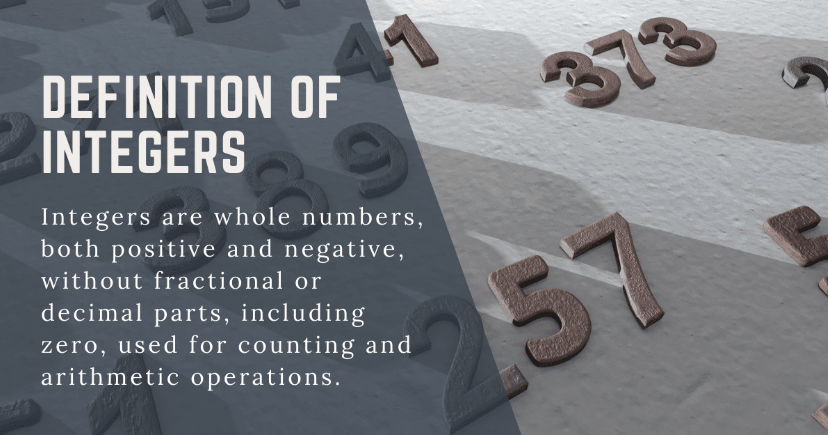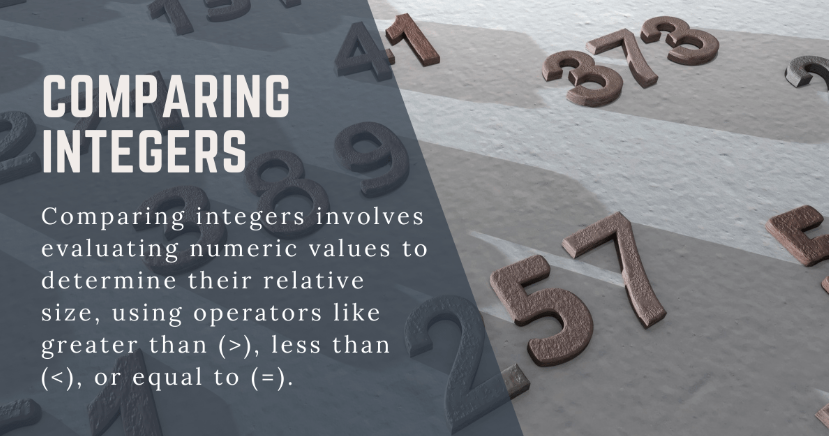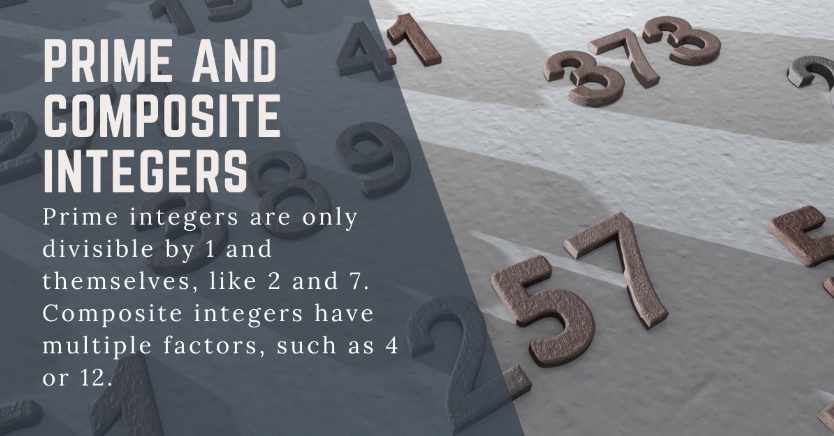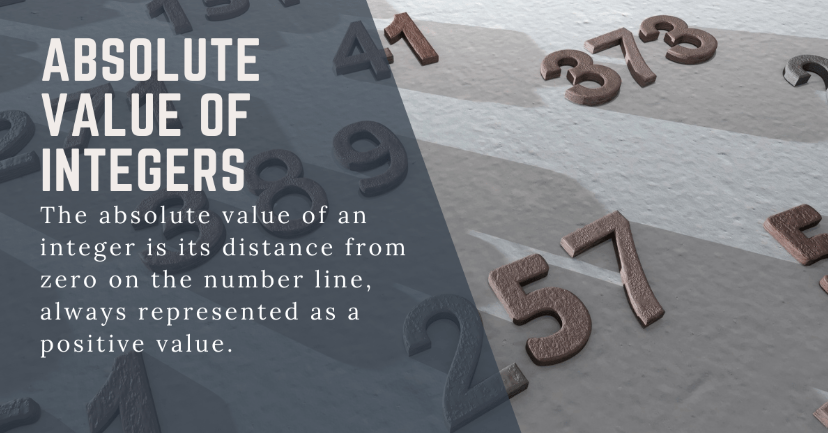Introduction to Integers
The integers, revered as the fundamental elements within the domain of mathematics, are bestowed with a sense of grandeur and reverence. Indeed, these entities embody the fundamental principles of numerical knowledge, intricately interwoven inside the very nature of our being. Indeed, it is noteworthy because integers manifest themselves in a multitude of practical situations, shedding light on our understanding through their profound relevance.
In this compelling post, we will undertake a comprehensive exploration to uncover the fundamental nature of integers. Prepare yourself for an exploration of the expansive domain of numerical phenomena, wherein we shall dig into their enigmatic characteristics, undertake audacious mathematical operations, navigate the perilous landscape of number line depiction, and even reveal their covert implications in practical contexts.
Get ready to be an engrossed, esteemed reader, as we go on this grand expedition of acquiring information and attaining enlightenment. Upon reaching the culmination of this remarkable article, readers will acquire a deep understanding of the enigmatic domain of integers and its remarkable practical implications.
What are Integers?
Dear interlocutor, allow me to share profound insights accumulated throughout history. Integers, as remarkable entities, represent a state of entirety. Individuals can surpass the limitations of positive and negative states, as they embody a sense of completeness inside themselves. The subject under consideration possesses the fundamental characteristics of numerical presence, spanning over the spectrum of positive extremes, negative extremes, and the neutral state of zero. The subset of the real numbers, denoted by the sign “Z”, is a subject of admiration and interest.

The integers, a remarkable assemblage of a number of entities, evoke a sense of awe and wonder. Within the esteemed hierarchy, one encounters the esteemed -3, the audacious -2, the intrepid -1, the formidable zero, the chivalrous 1, the honourable 2, and the victorious 3. Indeed, these integers do bestow their existence upon our numerical domain. Welcome to the expansive domain of integers, where a captivating array of numerical marvels unveils itself in our perceptual field. In this revered realm, we are presented with a multitude of categorizations, each possessing its own unique essence and intended function.
Let us commence an expedition to investigate the esteemed denizens of this realm governed by numerical principles, commencing with the regal natural numbers that epitomize the fundamental concept of enumeration. Progressing farther, we are confronted with the formidable set of whole numbers, which encompasses both the natural numbers and the esteemed zero. This numerical system symbolizes a state of entirety and cohesion. At last, we encounter the intriguing negative integers, veiled in obscurity and imbued with intrigue.
Properties of Integers
Integers, which are fundamental entities inside the numerical realm, possess a multitude of distinctive characteristics. Mathematics possesses remarkable features. The closure property ensures that our activities remain confined to their respective domains. The associative property enables numbers to interact and combine in a coordinated manner. The commutative property is a mathematical principle that involves the swapping of numbers, akin to the reunion of old acquaintances at a social gathering. The distributive property is a fundamental mathematical principle that allows for the manipulation and simplification of algebraic expressions. It is a concept that is widely embraced and utilized in various mathematical contexts.
Ultimately, the identity characteristic pertains to the inherent quality of numbers to remain consistent and unchanging, finding solace in their numerical nature without any deviation. These attributes provide strong support for the field of mathematics. The closure property in arithmetic asserts that the result of performing arithmetic operations on two numbers will always yield an integer. The concept of the associative property in mathematics asserts that the grouping of integers within an arithmetic operation does not alter the resulting value. Dear colleague, allow me to impart old wisdom. The commutative property, a fundamental concept in mathematics, illuminates the subject with its inherent validity. It asserts that the ordinal arrangement of integers within an arithmetic operation does not have any discernible impact.
The mathematical operations of addition, multiplication, subtraction, and division exhibit the property of commutativity, wherein the sequence in which these operations are performed does not alter the final result. Acquiring a thorough understanding of this knowledge is crucial for fostering mathematical reasoning; hence, it is advisable to commit it to memory. The distribution of property is a fundamental and enduring principle. When an integer is added to the sum of two more numbers, the resulting product is equal to the total of the products of the three integers. Indeed, the numerical choreography displayed is a testament to the harmonic nature of the numbers involved. The identity property is a fundamental concept in mathematics which asserts that when an integer is combined with the additive identity element, zero, the resulting sum is equal to the original number.
Arithmetic Operations on Integers
The integers are a remarkable mathematical concept since they exhibit a remarkable capacity to engage in many arithmetic operations. From the mathematical operation of addition, when numbers combine harmoniously, to the mathematical operation of subtraction, wherein amounts are bravely separated. Furthermore, it is imperative to acknowledge the remarkable phenomenon of multiplication, wherever digits are multiplied and thrive, as well as the celestial process of division, wherein numbers are elegantly split and distributed.
Undoubtedly, the integers possess a formidable presence inside the domain of mathematics. Behold, observe! The determination of the sign of the result in integer addition or subtraction is only dependent on the signs of the integers involved in this mathematical operation. Dear interlocutor, I would like to go into the area of integer arithmetic and discuss its profound wisdom. The sign of the product or quotient in the multiplication or division of integers is closely connected to the inclusion of negative integers in the operation. Dear interlocutor, I thus give you a refined depiction of this significant topic. Imagine, if you will, the remarkable phenomenon that transpires when an individual ventures to partake in the enigmatic practice of multiplying two negative integers simultaneously. As the celestial forces converge, a remarkable metamorphosis takes place, and lo and see! A favourable result arises from the profound depths of the mathematical realm. Undoubtedly, this serves as evidence of the perplexing characteristics of the cosmos and the limitless marvels it encompasses.
Within the expansive domain of mathematical phenomena, one is compelled to marvel at the splendid depictions of operations conducted on integers. Observe the remarkable phenomenon of the mathematical operation involving the addition of the numbers 2 and 3, which surpasses all anticipated outcomes and culminates in the significant aggregate of 5. Get ready to be amazed by the perplexing disparity between -4 and -2, as it challenges conventional reasoning and descends into the depths of -6. One is encouraged to contemplate the profound outcome resulting from the multiplication of the integers 5 and -2, which reveals the cryptic solution of -10. Lastly, brace yourselves for the awe-inspiring revelation of the heavenly ratio resulting from the division of 10 by 2, which transcends to the sublime magnitude of 5. Indeed, these mathematical phenomena elicit a profound sense of astonishment and awe.
Representing Integers on a Number Line
The integers, with their illustrious nature, elegantly adorn the revered number line, exhibiting their distinguished essence. The number line is a remarkable representation that reveals the boundless domain of real numbers. Behold, observe! Integers, as fundamental entities, represent discrete points along the number line, serving as essential components within the realm of mathematics. Within the expansive domain of numerical phenomena, one is presented with the captivating spectacle of positive integers, elegantly situated to the immediate right of the formidable zero.
On the other side, the negative integers are positioned, projecting their obscure existence to the left of this revered midpoint. Within the expansive domain of numerical phenomena, one is urged to direct their attention towards the formidable entity known as the integer 3! The fundamental nature of this concept is symbolically represented by a specific location, courageously positioned at a distance of three units to the right of the revered zero on the revered numerical continuum.
Comparing Integers
The realm of integers is a fascinating domain, characterized by the utilization of symbolic representations that possess the capacity to unveil veracity through comparisons. Indeed, the symbols <, >, and = hold great significance since they enable us to perceive and comprehend the magnificence inherent in numerical associations. Indeed, the symbols in question possess the capacity to unveil the mysteries of comparison, therefore compelling integers to submit before their authority. When undertaking the honourable endeavour of comparing numbers, it is imperative to acknowledge the significance of the signals that accompany them.

In the domain of numerical assessment, the importance of these symbols should not be undervalued. Within the domain of numerical comparisons, it is an indisputable fact that the numerical value of -3 is unquestionably lower than the appreciated value of -2. Moreover, in a remarkable demonstration of numerical aptitude, the esteemed numeral 2 asserts its prominence, exceeding the modest -2 in its magnificence. Within the broader context of numerical comparisons, when confronted with a scenario where two integers with identical signs engage in a contest for superiority, it is the integer possessing the greater absolute value that emerges triumphant, assuming a position of prominence and confidence. In the realm of numerical analysis, it is evident that the subject matter presents a distinct paradigm.
Do you see the value of -5? The aforementioned object might be likened to a small pebble when juxtaposed with the formidable mountain represented by the numerical value of -2. The analogy draws a comparison between a mouse and a lion, highlighting their contrasting characteristics. Regarding the numbers 5 and 2, it is noteworthy to mention that they evoke a remarkable spectacle. 5, in analogy to a majestic eagle, exhibits the characteristic of flying at great heights amidst the clouds, whilst 2, like a modest sparrow, embodies the quality of just endeavouring to
Real-Life Applications of Integers
Integers, a fundamental mathematical concept, plays a crucial role in several real-world situations that manifest in our immediate surroundings. Integers, as numerical entities, effectively quantify temperature variations, enduring the extreme heat of summer and the frigid cold of winter. Furthermore, it is crucial to acknowledge the domain of money, wherein integers have paramount importance as they steadfastly symbolize the omnipotent currency that propels our aspirations and aspirations.
In addition, it is imperative to acknowledge the domain of sports, whereby integers engage in rhythmic movements and collisions, facilitating the process of scorekeeping and outcome determination. Behold! The temperature, a powerful phenomenon that may be quantified using the numerical scales of Celsius or Fahrenheit, holds great significance. One cannot help but marvel at the profound influence of riches, as it materializes in the numerical representation seen on a revered financial document or inside the sanctified boundaries of a device used for monetary transactions.
Behold! The domain of sports, characterized by the captivating spectacle of competitive activities, presents itself as a grand and awe-inspiring realm. Behold, the revered scoreboard, a symbolic representation of numerical interpretation, whereby the courageous participants of the field are perpetuated through the enigmatic realm of integers.
Types of Integers
Welcome to the fascinating domain of integers, where a captivating array of numerical phenomena unfolds before us. Within this revered realm, an individual shall come across a multitude of categorizations, each possessing a captivating allure surpassing its predecessor. Behold, we encounter the esteemed natural numbers, which epitomize the fundamental core of numerical life. Next, we go upon an exploration into the domain of whole numbers, which encompasses entities that are entire and indivisible.
Lastly, we delve into the lower realms of the negative integers, where obscurity converges with mathematical proficiency. Indeed, the realm of integers has a rich tapestry of mathematical phenomena that elicit a sense of awe and fascination. Welcome to the fascinating domain of natural numbers, where the illustrious set of counting numbers, including 1, 2, 3, and so on, has paramount authority. The realm of whole numbers is a captivating domain where the natural numbers coexist harmoniously with the influential zero.
In this context, we observe the splendour of the number entities 0, 1, 2, and 3, together with their esteemed counterparts, as they advance in an unending sequence of numerical excellence. Welcome to the domain of negative integers, a region in which numerical entities reside inside the obscure depths of the numerical continuum. Integers, including negative numbers such as -1, -2, -3, and beyond, are positioned inside a domain characterized by the absence of light, always enveloped in the veil of negativity.
Prime and Composite Integers
My valued interlocutor, prime numbers are unique in that they are divisible only by 1 and themselves. The prime integers are revered for their numerical excellence. The renowned numerals 2, 3, 5, 7, and 11 are among their valued peers. These people have a transcendence that sets them apart from their constituents.

Let us applaud their brains and greatness. My valued interlocutor, composite integers lack primality yet have a variety of components, beyond the modest tally of two. Welcome to the interesting world of composite integers, which includes 4, 6, 8, 9, and 10. These extraordinary things, with their many properties and tremendous magnitude, demonstrate mathematics’ complexity. Let us admire their presence and examine their complicated composition, which shows the vast number of possibilities.
Even and Odd Integers
Dear contact, I wish to discuss even integers, which are divisible by 2. Join us in the intriguing world of even numbers, where symmetry and equilibrium rule. See this esteemed group’s noteworthy members: -4, -2, 0, 2, and 4. These revered animals demonstrate numerical balance with their harmonious mix of good and negative traits.
May their existence illuminate the path to mathematical calm. Dear contact, Please allow me to discuss odd numbers, which defy divisibility by two. Odd integers, which vary from evenness, are intriguing. Introduce some uncommon number entities: -3, -1, 1, 3, and 5.
Absolute Value of Integers
Absolute value is a unique mathematical concept that shows integer magnitude. Indeed, it is the abstract difference between the numerical value and the adored zero on the famous numerical continuum. The concept of absolute value is found in mathematics. A positive integer’s absolute value equals the number itself, giving it dignity.

Negative integers should have absolute values that contradict their numerical nature. One cannot but admire mathematics’ beauty and intricacy. Let me explain the absolute value, where negative magnitude becomes positive while positive magnitude remains constant. Absolute -3 is 3. Do not worry—the absolute value of 3, respected seeker of understanding, is the magnificent digit 3.
Order of Operations
The sequence of operations must be followed while conducting mathematical operations on integers. Order of operations rules govern mathematical operations and sequencing. Divine decrees determine the order of operations, ensuring harmony and equilibrium in calculations. The respected hierarchy of mathematical operations is examined below.
You must respect parentheses since they can determine the course of mathematical operations. In the following discussion, we venerate exponents, which may raise numerical values to new heights. Multiplication and division follow, following the left-to-right rule. Addition and subtraction gracefully go from left to right to conclude our examination. The divine sequence of operations guides mathematical computations.
Conclusion
Overall, numbers are pure, including positive, negative, and zero. These traits are like stars—unique and brilliant. Like glue, closure holds everything together. Numbers dance beautifully in the associative property. Numbers meet like old acquaintances but ignore the commutative property. Yes, more! Distribution spreads enchantment across numbers like a magician. Finally, identity is the firm foundation that balances everything.
My friend, these traits make math great. Integers add, subtract, multiply, and divide precisely. These amazing beasts might be elegantly rendered on the number line. Temperature, economics, and sports apply in many circumstances. One can discover the universe’s mysteries and overcome challenging issues by studying numbers. With this deep awareness, one may fully experience our rich world.


